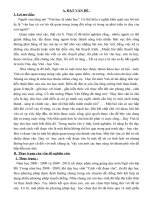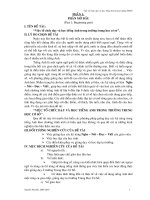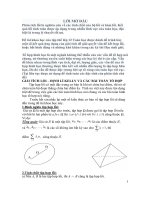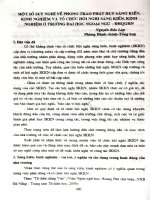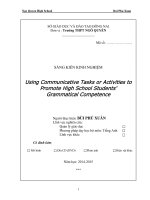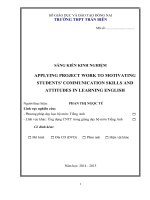SÁNG KIẾN KINH NGHIỆM: STEPS TO TEACH SLOW STUDENTS LISTENING SKILL
Bạn đang xem bản rút gọn của tài liệu. Xem và tải ngay bản đầy đủ của tài liệu tại đây (593.92 KB, 25 trang )
STEPS TO TEACH SLOW STUDENTS LISTENING SKILL
SỞ GIÁO DỤC VÀ ĐÀO TẠO HÀ NỘI
---------***--------MÃ SKKN:
____________
_
ĐỀ TÀI
SÁNG KIẾN KINH NGHIỆM
“CÁC BƯỚC DẠY KĨ NĂNG NGHE CHO
HỌC SINH YẾU KÉM”
Năm học: 2014- 2015
Page: 1/25
STEPS TO TEACH SLOW STUDENTS LISTENING SKILL
Hanoi Department of Education and Training
-------------------***--------------------
TOPIC
"STEPS TO TEACH SLOW
STUDENTS LISTENING SKILL"
School year: 2014-2015
Page: 2/25
STEPS TO TEACH SLOW STUDENTS LISTENING SKILL
INDEX
CONTENT
The topic of the study
Index
Part A: Introduction
I. Reasons
II. Scope of the study
III. Aims of the study
IV. Methods of the study
1. Methods of observation
2. Methods of survey
3. Experimental Methods
Part B: Development
I. Rationale
II. Practical basis
III. Overview of listening skill
1. Introduction
2. Definition of listening
3. Methods of teaching listening skill
4. Planning an effective listening lesson
5. Types of listening
6. Stages of listening
a. Before- Listening
b. While- Listening
c. Post- Listening
7. Syllabus
IV. Limitations and suggestions
V. Achievements
VI. Some issues to be studied
VII. Experience
VIII. Proposition
IX. Conclusion
References
Page: 3/25
PAGE
2
3
4
4
5
5
5
5
5
5
6
6
6
7
7
8
8
9
9
10
10
11
12
13
21
21
21
22
22
23
24
STEPS TO TEACH SLOW STUDENTS LISTENING SKILL
TOPIC
"STEPS TO TEACH SLOW STUDENTS LISTENING SKILL"
PART A: INTRODUCTION
I. REASONS
In this technological era, English, one of the international languages,
plays an indispensable role in enabling people in the world to have a good
understanding of each other’s culture, costume, lifestyle, etc. Especially,
Vietnam will have become a member of ASEAN Community by the end of this
year, the young all over the world by and large, throughout Vietnam in
particular, are going to have far more opportunities to have a well- paid job in
the future. However, it may be of a great challenge if they cannot communicate
in English, which is a major constraint in inventory integration. There are a
number of possible reasons for this.
As a matter of fact, Vietnamese students, particularly, schoolboys and
schoolgirls studying in high schools, cannot speak as well as listen to English
well by a simple reason they are not very good at both utilizing vocabularies and
pronouncing the sounds in English. Besides, the problem is that if the students
really are excellent, but they are more unlikely to prove to others know their
true ability, then perhaps they will hardly succeed in economic integration.
As far as is known, the Vietnamese are industrious and hard, all of which
used to be viewed as their greatness. Nevertheless, this concept must be changed
when Vietnam join ASEAN Communities. As a result, the young ought to
master the language to have the ability to work or fully compete with other
countries in the region.
It is essential for teachers to find out the most effective way of teaching
inasmuch as I believe that being good at listening to English will help learners
improve speaking skill, which means that they find it easier and more confident
to gain work as expected.
All in all, the above has given the writer of the thesis encouragement to
conduct the study entitled “ Steps to teach slow students listening skill”.
Within the scope of this study, the implementer hopes that students will
have a passion for learning about English.
Page: 4/25
STEPS TO TEACH SLOW STUDENTS LISTENING SKILL
II. SCOPE OF THE STUDY
In this study, the investigator has intention of helping students who are
bad at English overcome listening difficulties. These techniques were
experimented over a period of a term.
Due to the restricted time, the implementer cannot do the research for a
long time and study on a larger population. The research is done with the
participation of 96 students from two classes that have the same proficiency
level, that is, students in 12A7, 12A8 in 2014-2015 school year.
III. AIMS OF THE STUDY
With the successful research topic, the teacher is sure to get the following
experiences:
+ Assisting pupils in understanding the content of each unit.
+ Having the ability to listen to simple lessons.
+ Being more and more interested in studying English.
IV. METHODS OF THE STUDY
1. Methods of observation
The teacher did research after attending both the intensive course of
modern methods of teaching English held in the University of Languages and
International Studies( ULIS) and the Dyned course organized in Thai Thuy
primary school, Gia Lam, Ha Noi a year ago.
2. Methods of survey
The instructor showed a variety of ways to check the knowledge learners
gain after lesson.
3. Experimental methods
The implementor relied on objectives of this lesson to gain the best result.
Page: 5/25
STEPS TO TEACH SLOW STUDENTS LISTENING SKILL
PART B: DEVELOPMENT
I. RATIONALE
In reality, English is not only a compulsory subject in the national
curriculum but also a means of daily communication of a number of people.
What’s more, it is believable that English is the language which can not be
replaced in every field worldwide as well as opens the new world and helps
learners using it as their mother tongue be more and more successful in their
life.
Theorically, the teacher needs to be in charge of building the most
effective learning environtment to give students a hand with practising listening
to English as much as possible. Also, the trainer has to know how to coordinate
the different methods and exploits media with a view of attracting the students’
attention as well as making the students active and creative.
As you know, listening skill is difficult for most pupils in rural areas
because of numerous reasons. However, if the instructor can guide them step by
step, then the students will be far more interested in each lesson and make much
progress.
II. PRACTICAL BASIS
Most of the students studying in high schools come from small villages.
As a result, they do not have a good knowledge of English for a number of
reasons.
To begin with, they can be a bit timid whenever they have to speak
English in front of the crowd since they think that they will be made fun of if
they make mistakes.
Next, listening skill is so difficult that they cannot understand what the
speaker is saying. Gradually, they are not fond of studying English any more.
That’s the reason why they do not focus on the teacher’s any longer.
Besides, they have to do such a variety of things at home that they do not
find time to study English. More importantly, they cannot know how to
pronounce each sound and use intonation in English correctly, which hinders
them from listening to English.
Last but not least, the native speaker speaks English quickly. Furthermore,
the pupils’s source of vocabularies is limited. Hence, it is essential that the
teacher had better devote her time to each lesson.
Page: 6/25
STEPS TO TEACH SLOW STUDENTS LISTENING SKILL
In a nutshell, the instructor’s responsibilty is that help the students
overcome these problems.
At the turn of the school year, I always concentrate on investigating my
students’ ability through tests so I have noticed that most of them are lacking in
listening skill although some of them are excellent at English grammar. The
results of the survey of the early school year of 12A7 and 12A8 as follows:
Class
Number
of
students
Good
Quite good
Average
Bad
Very bad
SL
%
SL
%
SL
%
SL
%
SL
%
12A7
49
4
8.2
8
16,3
11
22,4
16
32,6
10
20.5
12A8
47
3
6.1
8
17.0
14
29.8
12
24.5
10
22.6
In point of fact, thanks to National Foreign Languages 2020 Project,
teaching as well as studying English is changed dramatically. The first reason is
that the teachers have to deepen their professional knowledge daily. Moreover,
they get used to using English to teach their pupils, which makes them as well as
their students improve speaking skill and listening one better and better. Also,
the teachers must help learners take English lessons actively to get the best
result.
According to this point of view, the teachers must have a good
knowledge of their speciality and know how to use innovative methods of
foreign language teaching and learning usefully in order to enable students to
speak and improve their English listening skill more effectively.
III. OVERVIEW OF LISTENING SKILL
1. Introduction
In the process of studying English, listening skill plays the most important
part as this skill makes learners enhance the ability to pronounce as well as
communicate in English
As far as the investigator is concerned, there are several factors affecting
listening skill. The first one is that the students do not have enough vocabularies.
Next, they lack concentration while listening. In addition, native speakers
produce spontaneous connected speech, etc...
Page: 7/25
STEPS TO TEACH SLOW STUDENTS LISTENING SKILL
Surely, a number of students were not good enough to comprehend what
they were listening to. As a result, the implementer requires to use a variety of
methods to help students overcome difficulties in listening comprehension.
2. Definition of listening
Brown (3, 2006) pointed out that listening is an activity which is carried
out once and there is no a second chance unless the listeners ask to repeat. It
means that students need to pay attention to listening to the text and can play the
tapes several times to improve their listening skill. Brown indicated that
listening activities in the class include three following stages such as beforelistening, while- listening and after- listening. So when students practise
listening to English at home had better do these activities as well.
3. Methods of teaching listening skill
a. Studying the way of pronunciation, stress and intonation
Grasping the method of pronunciation, stress and intonation is vital to
enable students to listen to English better, particularly in case learners listen to
the native speakers’.
Focus on the pronunciation of each new word and learn how to lay stress
on the important words in each sentence by making use of one of the most
reliable dictionaries namely, Longman Dictionary of Contemporary
English, Longman Advanced American Dictionary.
Therefore, make great effort to pronounce words in English perfectly to
achieve a great breakthrough in studying English, peculiarly listening skill.
b. Enriching a source of vocabularies
It is unavoidable that students should memorize vocabularies as much as
possible. For instance, learning new words by heart by recording them in a small
notebook, using suitable images and sounds.
Furthermore, pupils are compelled to review new words as well as study
the way of making sentences including these words regularly.
c. Knowing how to guess the meaning of new words in each situation
It is effortful to figure out the whole content while listening to the text.
Thus, students have to guess the meaning of new words through the dialogue
content, stress and intonation of that word. By predicting these, pupils can create
their own interesting topic by inferring participants, places, words that appear in
the test are based on the number of words heard or available, to conjecture the
sequence of events happening in the listening passage.
d. Arranging a suitable studying time
Page: 8/25
STEPS TO TEACH SLOW STUDENTS LISTENING SKILL
Listening skill requires pupils to work out everyday and for a long time.
For this reason, students need to spend their time practising listening to English
at home daily to gain the best achievement.
4. Planning an effective listening lesson
+ For teachers:
Think of the aim of the lesson carefully to help students with practising
and developing not only listening skill but also the other ones. After the section,
students understand the main content of the listening and made some requests or
exercise certain language exercises .
Looking into the content and requirement of each lesson from the
textbook to prepare for the most interesting syllabus. Be always active in every
teaching unit. Also, adjust time to teach each part appropriately and
scientifically.
Choosing listening techniques in a lofty way by relying on the content of
the lesson, characteristics as well as qualities of students in order for teachers to
have the different listening methods in 3 parts such as Pre-listening, Whilelistening, Post- listening.
Studying to know how to use visual aids, namely, a smart board, a radio,
pictures related to the lesson.
Using English songs, video clips at the beginning or at the end of the
lesson with activities about this song as an extra activity.
Take students’ expectations into consideration in order to help them
improve their listening ability.
+ For students:
The teacher asks students to prepare for the next lesson by giving them
open questions related to the next unit and encouraging them to be creative,
confident to raise questions referred to the lesson.
5. Types of listening
Each sort of listening will provide specific strategies for students to get the
highest marks.
A. Multiple choice
Firstly, read the requirement carefully and then underline the key words as
they are the major factors to support you to distinguish the given answers.
Simultaneously, choose the answer as soon as you listen to each question lest
you forget it on the spot. Especially, focus on different choices before listening
Page: 9/25
STEPS TO TEACH SLOW STUDENTS LISTENING SKILL
and while listening for the order of questions can be completely different from
that of the listening passage
Secondly, pay attention to connectors “ However, Unfortunately, Well…”
because these words are used as a sign of moving to the next sentence. In case,
you are unable to hear anything, guess and choose the best answer.
B. True/ False Predictions
This form is used for listening to a passage, a text or a conversation. So
students only give predictions based on existing knowledge.
C. Ordering Statements/ Pictures
Normally, in this exercise, students will listen to a story or a process by
looking at pictures or sentences to rearrange the order of the story or the process.
D. Open Predictions
By and large, this form asks students to fill in the gap or predict the data
and information. It is possible that students will fill the missing information in
the tables with columns of data. Sometimes, Networks / Brainstorm can be used
instead.
E. Pre-Questions.
The teacher gives some questions including the main meaning of the text
to attact students’ attention while they are listening. Students don’t have to guess
the answer. Nevertheless, the teacher plays the tape only once and asks students
to answer the question immediately.
6. Stages of a listening lesson
The listening lesson can be divided into 3 stages, for example, Prelistening, While- listening, Post- listening. Therefore, the teacher is more likely
to plan the most suitable method of teaching.
a. Pre-Listening
The pre- listening stage is of great significant which leads learners to the
listening passage they are listening to, exites them and provides them with the
purposes of listening so the teacher gives the interesting ways to attract the
students’ attention through setting up the context by asking them to depict the
pictures, answer some questions or read some new words aloud . Nevertheless,
the teacher ought to teach a few new words ( from three to five new words) to
provide an opportunity for students to guess the meaning of other ones.
Thus, the teacher also arouse students’ interest to make them far more
creative and self- confident. In the end, explain the number of listening times ( at
most three times) and the objective of this stage to students clearly. Also, the
Page: 10/25
STEPS TO TEACH SLOW STUDENTS LISTENING SKILL
teacher ought to choose the best methods to apply to this stage such as True/
False Statements, Predictions, Open Prediction, Ordering Statements/ Pictures,
Pre-Questions. These activities may support students to gain the common
knowledge that assists them in following the listening text.
Thence, the instructor needs to utilize appropriate kinds of activities.
b. While- Listening
The while- listening stage is composed of the main content students have
to be clear about as well as activities learners are asked to do during the time
they are listening to the text. This stage requires a great deal more challenging
and exciting activities than those of the pre- listening.
The content of the listening text can catch students’ fondness is that
depend on the instructor’s effort. Consequently, the teacher had better try to give
practice in predicting and matching to give educatees a hand with accomplishing
their listening task less perplexedly.
Methods of teaching and pupils’ interest decide the achievement of the
while- listening activities. For this reason, it is crucial that the teacher plan the
syllabus, including appealling activities or games based on the textbook. In
addtion, ask students to open the book to read the questions carefully for a while
before the teacher plays the tape. On the contrary, if the teacher does not take
advantage of the textbook, give handouts to pupils and ask them to look into the
questions to guess the correct answer. Through this activity, students are certain
to perceive the lesson easilier.
As you know, in the process of listening, students are going to make some
mistakes so the teacher requires to observe and help them with correcting these
errors.
Methods like Listening and Numbering Pictures, Multiple Choice, GapFilling, Comprehension Questions, Selecting, Delibrate Mistakes, Grids, Listen
and Draw, etc… need making use of properly to encourage students to
remember the content.
Likewise, the major goal of this part is that understanding the main
information or details. As a consequence, it is advisable that the teacher allows
students to listen to the text to understand the whole content and do exercises,
and then maybe get them to replay the segment or difficult sentences to confirm
the answer. Make sure that students should be set strict limits on listening to
every word in order to get used to listening to longer and more complex
passages.
Page: 11/25
STEPS TO TEACH SLOW STUDENTS LISTENING SKILL
Activities of this stage are supposed to be in line with students’
potentiality, which means that almost all movements in the while- listening
period should be carried out by learners at different levels.
c. Post- listening
In this phase, activities are done just as the listening is finished. This is the
last step to enable students to consolidate their understanding. First of all,
students are required to work in pairs. Next, they are asked to work in groups to
sort out problems that are more or less general language learning activities.
Unlike the previous periods, other than listening skill, the post- listening
work includes further skills such as speaking, reading and writing.
Additionally, the post listening stage requests students to complete a lot
trickier activities compared with those of the pre- listening in conjunction with
the while- listening. In that event, activities should be chosen to make students
motivated.
The teacher can single out one of the following forms, namely, Write- it–
up, Roleplay, Further Practice, Recall the story, Gap- filling, Transformation
Writing and so forth. Moreover, it can be seen that time should be permitted to
do the post- listening.
At last, information as well as mistakes from students ought to be
collected and checked or corrected.
In brief, when the teacher concentrates on this element properly, the
activity chosen for students will be more specific and effective.
Page: 12/25
STEPS TO TEACH SLOW STUDENTS LISTENING SKILL
7. Sample Syllabus
GRADE: 12- UNIT 8: LIFE IN THE FUTURE
PERIOD: 47 PART C: LISTENING
I. AIMS AND OBJECTIVES:
By the end of the lesson, students will be able to:
+ improving their listening skill : they can understand the passage about
life expectancy.
+ telling about some advantages and disavantages of life expectancy.
+ talking about factors leading to a healthy life as well as unhealthy life.
+ listening to a short sentence for detailed information.
II. ANTICIPATED PROBLEMS:
1. Vocabulary:
+ curable, mushroom…
2. Skills of practicing:
+ Speaking, listening (main skills)
3. Methods of teaching:
+ Gap – Filling, True/ False Statements/ Open Prediction/ Pictures, PreQuestions,
Comprehension Questions.
III. TEACHING AIDS:
+ English textbooks for students
+ English textbooks for teachers
+ Tapes and cassette
+ Video clips
+ Handouts
IV. PROCEDURES: (45 minutes)
Teacher’s activities and content
I.Warm - up (5’)
* Activity 1: - Say “ hello” to students.
- Check the number of students
* Activity 2:
- Ask students to watch a video clip and answer
the following question:
“ Which of the following factors do you think
Page: 13/25
Students’ activities
- Say “ hello” to the
teacher
- The monitor answer the
teacher’s.
- Watch a video clip
and anwer the question.
STEPS TO TEACH SLOW STUDENTS LISTENING SKILL
might help people have a long and healthy life?” * Suggestions:
- Call two or three students to talk about things - Fresh air.
that lead to a healthy life.
- Feeling relaxed.
- Doing morning
exercises.
- Eating a lot of
vegetables.
- Being happy.
- Don’t smoke, drink wine
* Activity 3: Lead into the new lesson
or eat meat.
Today, we will listen to a text about interview
about people’s life expectancy in the future.
- Write on the board :
UNIT 8: LIFE IN THE FUTURE
PERIOD: 47 PART C: LISTENING
II. Before you listen (10’)
Activity 1: Pre- teach vocabulary
Introduce some new words by eliciting ,
giving the definitions in English or its synonym
then ask students to translate them into
Vietnamese to check their understanding.
1. ‘curable/ ‘kjuərəbl/ (adj.) : = treatable (used
about a disease) that can be made better
2. ‘mushroom /ˈmʌʃrʊm/ (v): develop quickly
3. cente‘narian /ˌsentɪˈneriən/ (adj): belong to
the century, 100 years
4. e‘ternal /ɪˈtɜːrnl/ (adj): without an end;
existing or continuing forever
- Teacher has students pay much attention to the
words and how they’re pronounced and tells
students that they’re given cues helping them to
listen to the text well.
- Let the whole class read the new words twice
or three times.
Page: 14/25
- Work in the whole class
- Listen to the teacher.
- Guess the meaning of the
new words.
- Read the new words
STEPS TO TEACH SLOW STUDENTS LISTENING SKILL
- Call some students to read aloud new words
again
* Lead- in:
- The teacher gets students to do activity 2 by
choosing the best answer A, B, C or D to know
how to use new words.
Activity 2: Choose the best answer
1. Fatal diseases like AIDS and cancers can now
be _____
A. curable
B. treatable
C. untreatable
D. A & B
2. AIDS will also ___ under control.
A. bring
B. be brought
C. to bring
D. bringing
3. A____ is a person who lives over 100 years.
A. scientist
B. secretary
C. centenarian
D. interviewer
4. The population in Vietnam _____ today.
A. is mushrooming
B. mushrooms
C. has mushroomed
D. mushroomed
5. So far, ____ life is just science fiction. But
with the advance of science, it’s not impossible.
A. eternal
B. confidence
C. medical
D. affect
- Ask students to work individually to choose the
best answer.
Page: 15/25
- Work individual
- Look and choose the
best answer.
Suggestions:
1. D
2. B
3. C
4. A
5. A
STEPS TO TEACH SLOW STUDENTS LISTENING SKILL
- Give them about two or three minutes to do
this exercise.
- Call some students to read aloud their choice.
- Let other students give comments.
- Correct if neccesary.
III. While you listen (20’)
* Task 1: Listen and choose the best answer.
- Let students read the statements in handouts
carefully.
- Ask students to listen to the passage the first
time:
- Listen to an interview about people’s life
expectancy in the future, and choose the best
answer.
* Handouts:
1. ____can predict how long we will be able to
live in the 21st century.
A. Many people
B. All scientists
C. Many scientists
D. Some people
2. The centenarian population is mushrooming
as_______.
A. our general health decreases.
B. our health decreases.
C. our general health improves.
D. health improves.
3. Nowadays, if people look after themselves,
they can live to be______.
A. 45
B. 35
C. 80
D. 130
4. Nowadays, about 50% of cancers are curable,
and I really believe that within 30 years this will
increase to____.
A. 80
Page: 16/25
- Work individually
- Read the statements in
handouts.
- Listen to the passage.
- Choose the best answer.
- Compare answers with a
partner
* Suggestions:
1. C
2. C
3. C
4. A
5. B
STEPS TO TEACH SLOW STUDENTS LISTENING SKILL
B. 50
C. 81
D. 78
5. So far, eternal life is just ___ but with the
advance of science, it isn’t impossible.
A. science non- fiction
B. science fiction
C. scientific technology.
D. advanced technology.
- Play the tape twice
- Call some students to give their answers and
reasons for their answers. If their answers are
right, repeat them; if not give the correct
answers.
* Task 2: Lucky Letter
- Ask the whole class to play a game called “
Lucky letter”.
- Explain the rule of this game to students.
RULES
- One correct answer you have 10 points.
- If you answer the question incorrectly you will
get O point.
- If you cannot answer two questions on end,
you will not be allowed to answer any
questions.
- If you get “ Lucky letter”, you will be given
50 points.
- Which team has the highest score will be a
winner.
* Handouts:
Question 1: How many percentages are cancer
curable nowadays?
A. 15 %
B. 80 %
C. 90 %
D. 50 %
Question 2: What will we have been able to do
Page: 17/25
- Listen again to finish the
Task.
- Play the game “ Lucky
letter”.
- Listen to the teacher.
* Suggestions:
1. D
2. It will also be brought
under control
3. C
4. Wrong
5. True
6. In fact, their production
is based on researchand
on the fact that the
centenarian population is
mushrooming as our
general health improves.
7. Lucky letter
8. to be
to know
to clap
STEPS TO TEACH SLOW STUDENTS LISTENING SKILL
about AIDs in ten years’ time?
“______________________”
Question 3: What are the factors that help
people have longer life expectancy?
A. Eating more healthily, cutting down on
things like butter, alcohol and cigarettes.
B. Looking after ourselves and eating more
heathily
C. A and B are correct
Question 4: Right or wrong?
The development in medical science is the
most important factor as somebody dies from
the old age, just from the diseases that affect
them when they are older.
Question 5: TRUE OR FALSE?
Eternal life is just science fiction.
Question 6: Correct the sentence
In fact, their production is based on
research and on the fact that the centenarian
population are mushrooming as our general
health improves.
Question 7: Lucky letter
Question 8: Listen to this song and can you tell
how many verbs used in this song and put them
in the correct order.
“ If you are happy and you know it, clap your
hands
If you are happy and you know it, and you
really want to show it
If you are happy and you know it, clap your
hands
If you are happy and you know it, click your
fingers
If you are happy and you know it, and you
Page: 18/25
to want
to show
to click
to tap
to nod
9. Lucky letter
STEPS TO TEACH SLOW STUDENTS LISTENING SKILL
really want to show it
If you are happy and you know it, click your
fingers
If you are happy and you know it, tap your
shoulders
If you are happy and you know it, nod your
head”
Question 9: Lucky letter
- Do “ After you listen” in
groups of 6 people.
- Report what they have
discussed
- Listen to the teacher and
correct the mistakes
Advantages:
- The class is divided into two teams: one
Do a lot of things they
called Tom and the other called Jerry.
want to do/ enjoy life
- Ask students to work in groups.
more.
IV. After you listen (7’)
See their children and
- Ask students to do “After you listen” in groups
grandchildren grow up.
of six people.
Help their children
- Allow students to watch this clip and discuss
advantages and disadvantages of having a long and grandchildren.
Children and
life.
grandchildren are cheerful
with them.
Disadvantages:
Too weak to do things
and often ill.
Question 1: What are the advantages of having
Feel lonely when
a very long life?
children have grown up
Question 2: What are the disadvantages of
and busy with their own
having a very long life?
lives, and friends are
- Go around to supervise them. Note down
dead.
serious and common mistakes.
- Ask one group to report what they have
discussed
Page: 19/25
STEPS TO TEACH SLOW STUDENTS LISTENING SKILL
- Give comments after they finish
- Call another group if there is enough time
- Give feedback and correct serious or common
mistakes
- Listen to the teacher
- Write down in the
notebook.
V. Consolidation (2’)
- Retells the main points of this lesson.
V. Homework ( 1’)
- Prepare for the next lesson: Part D: Writing
- Rewrite the summary( about 100 words”
TAPECRIPT:
LIFE IN THE FUTURE
Interviewer: Many scientists predict that in the 21st century people will be living
into the incredible age of 130. What do you think about this?
Dr. Davis: Well, I quite agree with them. They have reasons to be confident
about that.
Interviewer: What are the reasons?
Dr. Davis: In fact, their prediction is based on research and on the fact that the
centenarian population is mushrooming as our general health improves.
Interviewer: Can you explain this further?
Dr. Davis: A century ago average life expectancy in Europe was 45. Today,
providing we look after ourselves, eat more healthily, cut down on things like
butter, alcohol and cigarettes, we can add nearly 35 years to that figure.
Interviewer: So these are the factors that help people live longer?
Dr. Davis: Yes. But the most important factor is the development in medical
science.
Interviewer: What do you mean?
Dr. Davis: Nobody dies from old age, just from diseases that affect people when
they get older.
IV. LIMITATIONS AND SUGGESTIONS
Page: 20/25
STEPS TO TEACH SLOW STUDENTS LISTENING SKILL
Although much effort has been made, the limitations of this research are
unavoidable. The first reason is that time is not long enough for the investigator
to have precise judgments. Consequently, the study would be better if these
methods were experimented on a larger scale. Secondly, since the investigator’s
practical experiences in teaching listening and knowledge of this field are
limited. Also, the implementer needs to make great effort to study as well as
improve knowledge by herself or from colleagues, books and media and apply
numerous methods to each lesson to catch students’ attention.
To sum things up, as listening is only one of the four basic aspects in
teaching and learning English, it is, therefore, important that students should
listen to English intensively and extensively as soon as posible.
V. ACHIEVEMENTS
First and foremost, the teacher is certain that this way of teaching will be
applicable to students in grade 12 in high schools. Students seem to take much
more pleasure in listening to English. The atmostphere in the class is more
comfort and the students are more active. Particularly, pupils who can be a bit
shy and a little bad at English seem happier and more forceful when they are
able to listen to as well as speak some simple sentences. Apparently, this is a
good sign for not only the teacher but also students. Secondly, these ways of
teaching also are suitable for the content of the textbook, which assists learners
in making out the lesson.
The results of the survey of the late school year of 12A7 and 12A8 as
follows:
Class
Number
of
students
12A7
12A8
Good
Quite
good
SL %
Average
SL
%
49
8
16.3 15
30.6 14
28.6 7
14.3 5
10.2
47
6
12.8 11
23.4 16
30.0 6
12.8 8
6.9
Page: 21/25
SL
%
Very bad
SL
VI. SOME ISSUES TO BE STUDIED
%
Bad
SL
%
STEPS TO TEACH SLOW STUDENTS LISTENING SKILL
In my capacity as a teacher of English, I found some advantages and
disadvantages:
1. Advantages
On the one hand, teachers teaching in high schools are industrious, patient
and competent. On the other hand, almost all students are hard working.
Besides, teachers of English have been trained to improve their knowledge in
famous and reputable English centers as well as universities for a long time.
Moreover, leaders of high schools and educational authorities always join a
hand to help teachers record great achievements.
2. Disadvantages
In effect, most students are not very good at English, which causes them
not to take interest in studying this subject at all. In addition, some of them
believe that foreign languages are beside the point so they have bad behaviours
in the class such as being talkative, not being care about what the teachers are
saying, etc...And teachers do not sometimes feel excited or lose their
enthusiasm in each lesson. However, teachers of English are really in need of
spending much more time changing their lesson into students’ interest.
VII. EXPERIENCE
Studying foreign languages requires both a long time and industriousness.
Therefore, teachers as well as students try to have the most interesting and
effective lessons.
VIII. PROPOSITION
Based on theriotical and practical foundation with purposes as well as
achivements of teaching and learning English, I gained the following
experiences:
As for teachers:
+ Being clear about students’ quality, ability and interest to take advantage
of a variety of methods of teaching that are concordant with them.
+ Making every effort to creat the comfortable, vivid and productive
studying environment.
+ Being aware of the objectives of the lecture to make use of appropriate
teaching methods.
+ Advancing capacity and expertise on end.
+ Exploiting media to inspire students to study better.
As for students:
Page: 22/25
STEPS TO TEACH SLOW STUDENTS LISTENING SKILL
+ Finding much more time to study English at school as well as at home.
+ Listening to the lecture, English songs and news and so on.
+ Taking avantage of media, namely, internet, a radio, etc.
+ Helping friends who are not very good at English to enable them to
make much progress.
+ Being more self- confident. Don’t be shy when speaking English.
+ Trying to correct mistakes by themselve.
+ Making use of each situation to practice speaking as well as listening to
English as much as possible.
As for leaders:
+ Helping teachers do well at school and allowed them to take
professional training courses.
+ Introducing educational materials related to teachers’s speciality.
IX. CONCLUSION
Being one of the teachers of English in high schools, the investigator can
see deeply the current situation of teaching and learning English. Listening skill
is by both the teachers and the students considered the most difficulty to
achieve among four skills. That is a reason why teachers of English had better
fortify and improve the quality of each lecture, bring about the best teaching
method to lend their pupils a helping hand with speaking or listening to English
fluently.
In the scope of this initiative, I would like to present my own teaching
way of listening skill in the hope that I can share this method with my
colleagues to make teaching and studying English in rural areas more and more
useful.
To finish this initiative, I sincerely thank the school administrators,
colleagues and students in 12A7 and 12 A8 for having been in favour of me!
Hà Nội, ngày 18 tháng 05 năm 2015
Tôi xin cam đoan đây là SKKN
của mình viết, không sao chép
nội dung của người khác.
Page: 23/25
STEPS TO TEACH SLOW STUDENTS LISTENING SKILL
REFERENCES
1. Các tài liệu tham khảo 1. SGV, SGK 12 của Bộ GD-ĐT.
2. English language Teaching Methodology của Bộ GD-ĐT 2003.
3. Đánh giá trong Giáo dục của Bộ GD-ĐT.
4 Tài liệu tập huấn đổi mới phương pháp môn tiếng Anh THPT.
5. Phương pháp dạyTiếng Anh trong trường phổ thông.(Tác giả: Nguyễn Hạnh
Dung)
10. Teach English. ( Adrian Doff )
6. Một số vấn đề đổi mới chung về đổi mới phương pháp dạy học ở trường
THPT (Berlin/ Ha Noi 2010)
Page: 24/25
STEPS TO TEACH SLOW STUDENTS LISTENING SKILL
Ý KIẾN ĐÁNH GIÁ CỦA HỘI ĐỒNG KHOA HỌC CẤP THÀNH PHỐ
.................................................................................................................................
.................................................................................................................................
.................................................................................................................................
.................................................................................................................................
.................................................................................................................................
.................................................................................................................................
.................................................................................................................................
.................................................................................................................................
...............................................................................................................................
Hà Nội, ngày
tháng
năm 2015
Chủ tịch hội đồng
Page: 25/25

